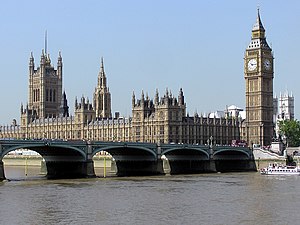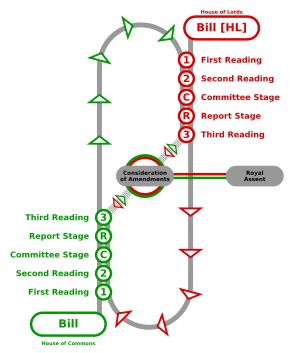Parliament of the United Kingdom - Simple English Wikipedia, the free encyclopedia

The Parliament of the United Kingdom of Great Britain and Northern Ireland is the highest political-legislative and legislative body in the United Kingdom and British overseas territories. It alone has parliamentary sovereignty over all other political bodies. The parliament has an upper house, the House of Lords, and a lower house, the House of Commons. At its head is the monarch, King Charles III. The monarch is the third part of Parliament. The British people choose the people in the lower house (members of parliament) in elections.
The development of parliament started with the councils of bishops and earls that advised the kings and queens of the Middle Ages. In 1707, during the early modern period, the Parliament of England and the Parliament of Scotland joined to become the Parliament of Great Britain. The first Parliament of the United Kingdom came into existence in 1801, after the Irish Parliament joined with the Parliament of Great Britain. Between 1801 and 1927, the British legislature's name was the Parliament of the United Kingdom of Great Britain and Ireland.
How the British Parliament works
[change | change source]The Parliament of the United Kingdom is split into three separate parts, the House of Commons (the lower house), the House of Lords (the upper house) and the monarch. Most legislative power is concentrated in the House of Commons. It is made up of 650 members of parliament (MPs). These people are elected by the people of the United Kingdom to represent them in the House of Commons. The leader of the political party who commands a majority of MPs is usually made the prime minister of the United Kingdom, the head of government. The head of state is always the monarch.
The House of Commons starts most bills. Other bills start in the House of Lords. The House of Commons decides rates of taxation.
The House of Lords has the power to reject bills, except money bills (tax bills), and make the House of Commons reconsider them. If the House of Lords vetoes a bill twice or delays a public Bill for more than one year then the House of Commons can force the Bill through under the terms of the Parliament Acts, unless it started in the House of Lords.
The monarch (now King Charles III) is the sovereign in a constitutional monarchy and, theoretically, is the fount of all power in the United Kingdom. Bills must receive the Royal Assent before becoming Acts of Parliament and the monarch is responsible for summoning, proroguing and dissolving Parliament, normally upon the advice of the incumbent Prime Minister. It is now very rare for a monarch to object, but the sovereign still retains this prerogative for use if necessary.
How a Bill becomes an Act of Parliament
[change | change source]
Bills may start their passage in either the House of Commons or House of Lords
Pre-legislative Scrutiny: Joint committee of both houses review bill and vote on amendments that government can accept or reject. Reports are influential in later stages as rejected committee recommendations are revived to be voted on.
![]() First Reading: No vote occurs. Bill is presented, printed, and in private members' bills, a Second Reading date is set.
First Reading: No vote occurs. Bill is presented, printed, and in private members' bills, a Second Reading date is set.
![]() Second Reading: A debate on the general principles of the bill is followed by a vote.
Second Reading: A debate on the general principles of the bill is followed by a vote.
Committee Stage: A committee considers each clause of the bill, and may make amendments.
Report Stage: An opportunity to amend the bill. The House consider clauses to which amendments have been tabled.
![]() Third Reading: A debate on final text as amended. In the Lords, further amendments may be tabled at this stage.
Third Reading: A debate on final text as amended. In the Lords, further amendments may be tabled at this stage.
Passage: The bill is then sent to the other House which may amend it.
![]() First Reading: Same procedures
First Reading: Same procedures
![]() Second Reading: Same procedures
Second Reading: Same procedures
Committee Stage: Same procedures
Report Stage: Same procedures
![]() Third Reading: Same procedures
Third Reading: Same procedures
Passage: The bill is then returned to the original House.
Pre-legislative Scrutiny: To consider all amendments.
The bill is then processed for Royal Assent, if accepted, the bill becomes an Act.
History
[change | change source]In the Middle Ages and early modern period there were three kingdoms within the British Isles — England, Scotland and Ireland — and these developed separate parliaments. The 1707 Acts of Union brought England and Scotland together under the Parliament of Great Britain, and the 1800 Act of Union included Ireland under the Parliament of the United Kingdom. The parliament at Westminster in London is sometimes called the "Mother of all Parliaments"[1]
Parliament of England
[change | change source]The English Parliament has its origins in the Anglo-Saxon Witenagemot. In 1066, William of Normandy brought a feudal system, where he sought the advice of a council before making laws. In 1215, this council received Magna Carta from King John, which established that the king may not levy or collect any taxes (except the feudal taxes to which they were so far accustomed), save with the consent of his royal council, which slowly developed into a parliament.
In 1265, Simon de Montfort, 6th Earl of Leicester called the first elected Parliament. The Laws in Wales Acts of 1535–42 annexed Wales as a part of England and brought Welsh representatives to Parliament.
When Elizabeth I was succeeded in 1603 by the Scottish King James VI of Scotland (James I of England) the countries both came under his rule, but each kept its own Parliament.
Parliament of Scotland
[change | change source]In Scotland in the High Middle Ages the King's Council of Bishops and Earls was the beginning of the Parliament of 1235.
Parliament of Ireland
[change | change source]The Irish Parliament was founded to represent the English community in the Lordship of Ireland, but the native or Gaelic Irish were not allowed to vote or stand for office, the first known meeting being in 1264. In 1541 Henry VIII declared the Kingdom of Ireland. The Gaelic Irish lords were now entitled to attend the Irish Parliament as equals of the majority of English descent.
Related pages
[change | change source]- MPs elected in the UK general election, 2005
- Parliament of England
- List of Parliamentary constituencies in the United Kingdom
- Parliamentary procedure
References
[change | change source]- ↑ Jones, Clyve. (2012). A short history of Parliament: England, Great Britain, the United Kingdom, Ireland and Scotland, p1; excerpt, "It is a commonly held misconception that the Westminster parliament is the 'mother of all parliaments' ... but the original phrase in 1865 was 'England is the mother of all parliaments'"
Further reading
[change | change source]- Blackstone, Sir William 1765. Commentaries on the Laws of England. Oxford: Clarendon Press.
- Davies M. 2003. Companion to the Standing Orders and guide to the proceedings of the House of Lords, 19th ed. Archived 2005-12-19 at the Wayback Machine
- Farnborough, Thomas Erskine, 1st Baron 1896. Constitutional history of England since the Accession of George the Third, 11th ed. London: Longmans, Green and Co.
- "Parliament." (1911). Encyclopædia Britannica, 11th ed. London: Cambridge University Press.
Other websites
[change | change source]- The Parliament of the United Kingdom. Official website.
- The Parliamentary Archives of the United Kingdom. Official website.
- History of Parliament. Official website.
- The British Constitution Archived 2011-08-12 at the Wayback Machine A general introduction to the principles underlying the UK Constitution
- The Parliament of the United Kingdom. Parliament Live TV.
- Provides online viewing of debates in The House of Lords, House of Commons and Westminster Hall debates. In addition, committee meetings can be viewed live or viewed from beginning to end. Using a 56k dial up connection streamed debates can be followed, though with erratic video and sound prone to disruption.
- The British Broadcasting Corporation. (2005). "A–Z of Parliament."
- Information links to Government, political parties and statistics. Archived 2007-08-11 at the Wayback Machine
- The Guardian. (2005). "Special Report: House of Commons." Archived 2007-10-26 at the Wayback Machine
- The Guardian. (2005). "Special Report: House of Lords."
- Parliamentary procedure site at Leeds University Archived 2017-10-12 at the Wayback Machine
- Works by the Parliament of the United Kingdom at Project Gutenberg


 French
French Deutsch
Deutsch